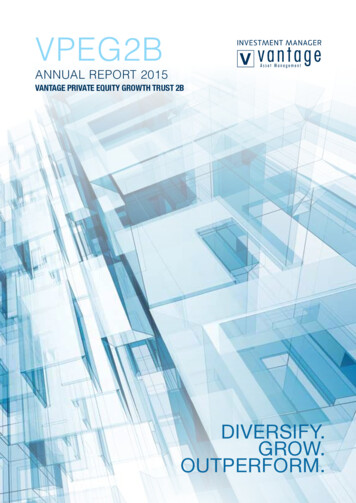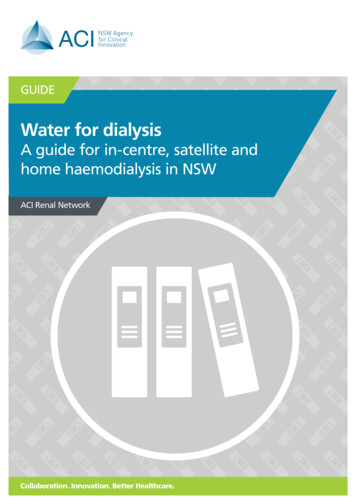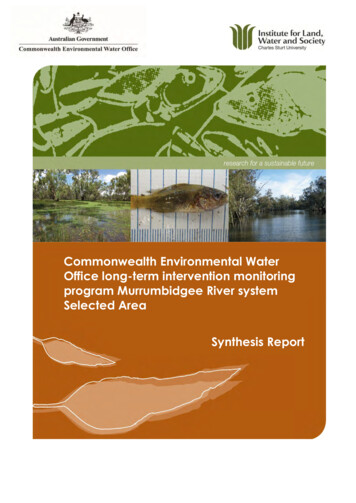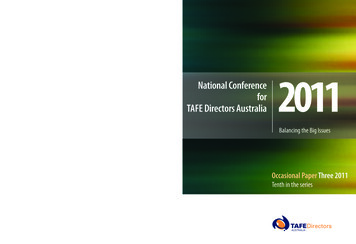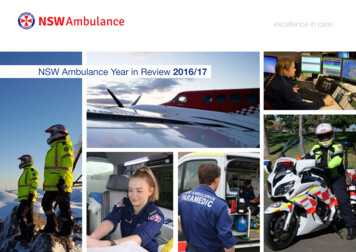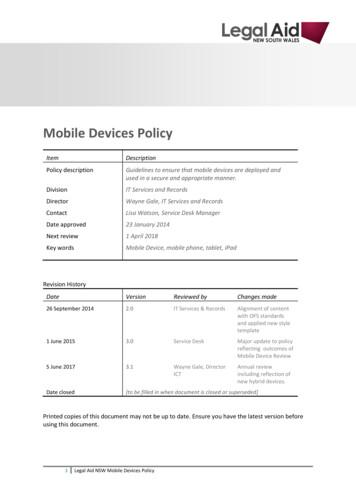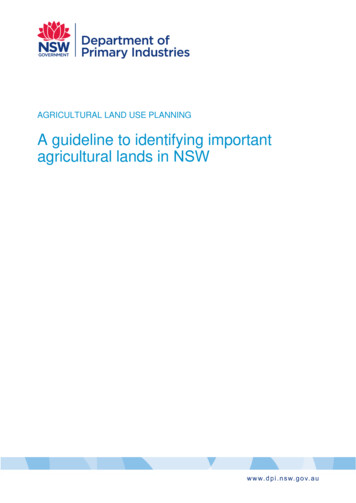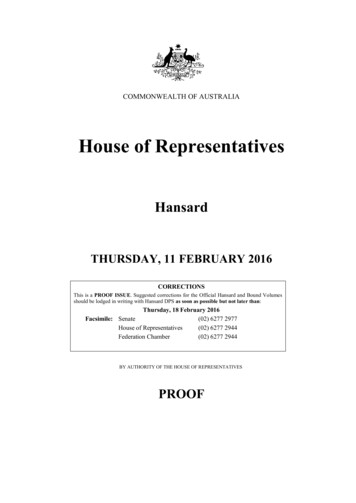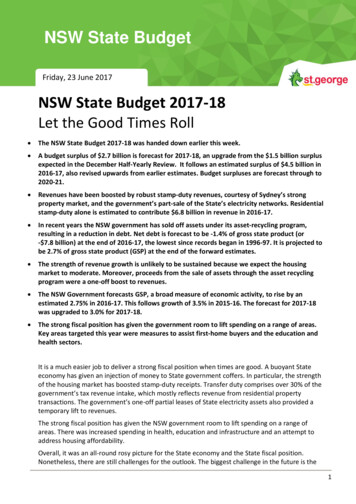
Transcription
Friday, 23 June 2017NSW State BudgetFriday, 23 June 2017NSW State Budget 2017-18Let the Good Times Roll The NSW State Budget 2017-18 was handed down earlier this week. A budget surplus of 2.7 billion is forecast for 2017-18, an upgrade from the 1.5 billion surplusexpected in the December Half-Yearly Review. It follows an estimated surplus of 4.5 billion in2016-17, also revised upwards from earlier estimates. Budget surpluses are forecast through to2020-21. Revenues have been boosted by robust stamp-duty revenues, courtesy of Sydney’s strongproperty market, and the government’s part-sale of the State’s electricity networks. Residentialstamp-duty alone is estimated to contribute 6.8 billion in revenue in 2016-17. In recent years the NSW government has sold off assets under its asset-recycling program,resulting in a reduction in debt. Net debt is forecast to be -1.4% of gross state product (or- 7.8 billion) at the end of 2016-17, the lowest since records began in 1996-97. It is projected tobe 2.7% of gross state product (GSP) at the end of the forward estimates. The strength of revenue growth is unlikely to be sustained because we expect the housingmarket to moderate. Moreover, proceeds from the sale of assets through the asset recyclingprogram were a one-off boost to revenues. The NSW Government forecasts GSP, a broad measure of economic activity, to rise by anestimated 2.75% in 2016-17. This follows growth of 3.5% in 2015-16. The forecast for 2017-18was upgraded to 3.0% for 2017-18. The strong fiscal position has given the government room to lift spending on a range of areas.Key areas targeted this year were measures to assist first-home buyers and the education andhealth sectors.It is a much easier job to deliver a strong fiscal position when times are good. A buoyant Stateeconomy has given an injection of money to State government coffers. In particular, the strengthof the housing market has boosted stamp-duty receipts. Transfer duty comprises over 30% of thegovernment’s tax revenue intake, which mostly reflects revenue from residential propertytransactions. The government’s one-off partial leases of State electricity assets also provided atemporary lift to revenues.The strong fiscal position has given the NSW government room to lift spending on a range ofareas. There was increased spending in health, education and infrastructure and an attempt toaddress housing affordability.Overall, it was an all-round rosy picture for the State economy and the State fiscal position.Nonetheless, there are still challenges for the outlook. The biggest challenge in the future is the1
Friday, 23 June 2017projected drop in revenue growth over the next few years. The recent pace of revenue growth isunlikely to be sustained given the one-off impact of asset sales and a likely moderation in housing.The State government expects weaker growth in property transfer duties in coming years.Nonetheless, there are downside risks given the chance of a larger cyclical downturn in housing.Economic ImpactThere are elements of the State Budget which are positive for the economic growth outlook,particularly in the near term.Public infrastructure spending has helped support economic growth over the past few years. Itshould help enhance productivity over the long-term and props up job growth. The Stategovernment has announced 72.7 billion worth of infrastructure spending over the next fouryears. NSW Treasury estimates that public investment will boost economic growth by an averageof 0.5 percentage points a year over the next two years.One of the key areas of focus was the measures to assist first-home buyers. Housing affordabilityhas become a major social issue, and follows some Federal Budget measures aimed at addressinghousing affordability. Of all policy changes to the housing market announced over the past fewmonths, the NSW State Government’s exemption of stamp duty for first-home buyers will likelyhave the most pronounced effect. Stamp duty will be abolished for both new and existingdwellings for first-home buyers up to 650,000. Previously the threshold was 550,000 and onlyapplied to new dwellings. There will be concessional rates applying for homes up to 800,000. Thestamp-duty exemption should help affordability for first-home buyers from 1 July. However, thiseffect will likely only be temporary – over the long-term, it will add to demand and push updwelling prices, potentially exacerbating the affordability problem over the long term. That beingsaid, stamp duty is viewed as an inefficient tax as it hinders turnover in housing, and preventspeople moving to properties more suited to changing lifestyles.The other key areas targeted this year were education and health. Infrastructure spending remainsan ongoing theme. Sydney will in the future get 3 new motorways: M12 (linking M7 to the futureBadgery’s Creek airport), F6 (motorway in Southern Sydney) and M9 (outer orbital from Box Hill).Economic Forecasts2
Friday, 23 June 2017The forecasts for the economic outlook seem reasonable and within reach. It paints a picture of aNSW economy that should remain robust over the forecast period.Very weak wages growth poses downside risk to the NSW (and wider Australian) economy throughrestraining consumer spending. However, unlike the Federal Budget, this State Budget hasprovided more conservative projections for wages growth.NSW’s credit rating has the highest possible rating and this should be retained with this Budget.Key Measures in the BudgetFirst-home Buyers New measures that will help first-home buyers enter the market were confirmed in theBudget. From 1 July 2017, transfer duty will be abolished for first home buyers on homes up to 650,000 and reduced for properties between 650,000 and 800,000. Insurance duty onlender’s mortgage insurance will also be abolished. 10,000 grants to first home buyers for purchasing new homes up to 600,000. 10,000 grants also available to people who build their first home on vacant land andwhere total value of house and land does not exceed 750,000Other housing buyers From 1 July 2017, duty on lenders mortgage insurance for all buyers will be abolished.Foreign Investors From 1 July 2017, foreign investor transfer duty surcharge will increase from 4% to 8%. Land tax surcharge of 0.75% will increase to 2.0% per annum from the 2018 land tax year.Infrastructure The State government has committed 72.7 billion to infrastructure investments over thenext four years to 2020-21. This includes 7.2 billion for the third stage of WestConnex, 4.9 billion over four years for Sydney Metro City and South West and 3.5 billion over fouryears for the Pacific Highway upgrade.Hospitals 7.7 billion investment over four years to be spent on health.This includes the redevelopment of existing hospitals and the building of new hospitals.These include Randwick Hospital Campus, Campbelltown, Tweed, Nepean, Maitland,Concord, Shellharbour, Hornsby, Wyong, Wagga Wagga, Coffs Harbour, Goulburn, Mudgee,Sydney Children’s hospital network Westmead, Inverell and Cooma.Investment in over 4,500 extra nurses, midwives, doctors and allied health professionals.Education The Budget announces increased education expenditure with the student population atNSW Government schools anticipated to growth by 21% (164,000) over the next 15 years.A sum of 4.2 billion will be invested over the next four years towards 90 new schools andupgrades of schools, delivering more than 1,500 new classrooms. There will be funding for1,000 extra teachers and wireless internet access in more than 900 regional schools. 2.23
Friday, 23 June 2017 billion of these new capital works will commence over the next two years.In a further hand out for children, the Active Kids rebate (a non-means tested measure) willpay parents 100 for each school-aged child who participates in sport or swimming lessons.This will cost 207 million over the four years.Sports, Arts, and Culture The Budget provides 1.8 billion over four years to transform the Art Gallery of NSW into aglobal art museum capable of hosting more major exhibitions.There is additional funding for the Sydney Opera House renewal program, Western SydneyStadium in Parramatta, national parks and gardens for education, and research, regionalarts and cultural activities to enhance visitor experiences.Jobs and Small Businesses A range of insurance tax cuts to reduce the operating cost of small businesses from 1January 2018.Businesses with aggregate turnover less than 2 million will be exempt from paying dutieson insurance for commercial vehicles, professional indemnity and public liability.Small businesses however, might be disappointed that there was no tax relief from payrolltax in this Budget.Farming Abolition of insurance duty on crop and livestock insurance from 1 January 2018.Regional NSW A 1.3 billion regional growth fund” to create jobs and build regional sporting & cultureinfrastructure.4
Friday, 23 June 2017Contact ListingChief EconomistSenior EconomistSenior EconomistBesa Dedadedab@stgeorge.com.au(02) 8254 3251Josephine Hortonhortonj@stgeorge.com.au(02) 8253 6696Janu Chanchanj@stgeorge.com.au(02) 8253 0898The information contained in this report (“the Information”) is provided for, and is only to be used by, persons in Australia. The information may notcomply with the laws of another jurisdiction. The Information is general in nature and does not take into account the particular investment objectivesor financial situation of any potential reader. It does not constitute, and should not be relied on as, financial or investment advice orrecommendations (expressed or implied) and is not an invitation to take up securities or other financial products or services. No decision should bemade on the basis of the Information without first seeking expert financial advice. For persons with whom St.George has a contract to supplyInformation, the supply of the Information is made under that contract and St.George’s agreed terms of supply apply. St.George does not represent orguarantee that the Information is accurate or free from errors or omissions and St.George disclaims any duty of care in relation to the Information andliability for any reliance on investment decisions made using the Information. The Information is subject to change. Terms, conditions and any feesapply to St.George products and details are available. St.George or its officers, agents or employees (including persons involved in preparation of theInformation) may have financial interests in the markets discussed in the Information. St.George owns copyright in the information unless otherwiseindicated. The Information should not be reproduced, distributed, linked or transmitted without the written consent of St.George.Any unauthorised use or dissemination is prohibited. Neither St.George Bank - A Division of Westpac Banking Corporation ABN 33 007 457 141 AFSL233714 ACL 233714, nor any of Westpac's subsidiaries or affiliates shall be liable for the message if altered, changed or falsified.5
Friday, 23 June 2017 1 NSW State Budget 2017-18 Let the Good Times Roll The NSW State Budget 2017-18 was handed down earlier this week. A budget surplus of 2.7 billion is forecast for 2017-18, an upgrade from the 1.5 billion surplus expected in the December Half-Yearly Review. It follows an estimated surplus of 4.5 billion in
